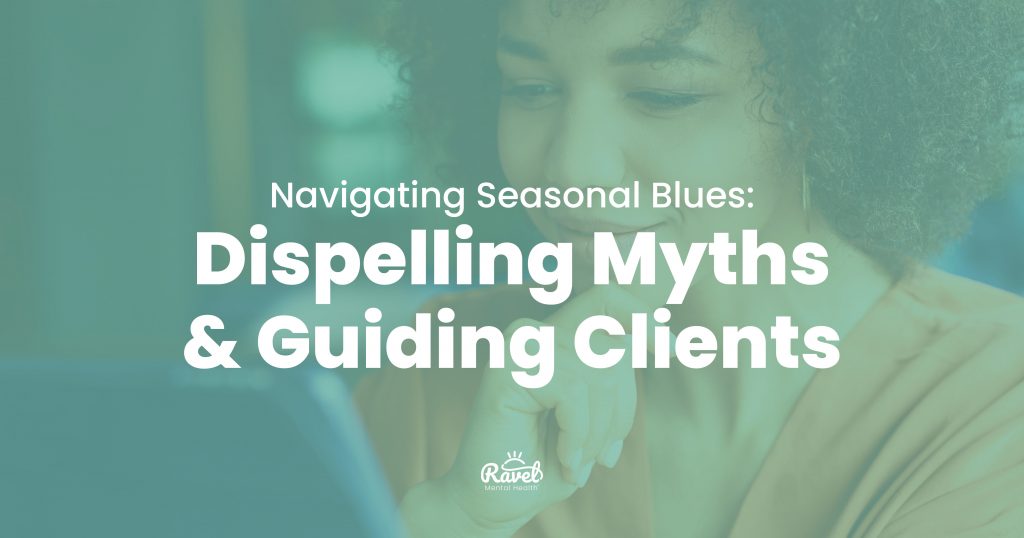As the days grow shorter, the weeks are busier, and the months get colder, many of us experience a shift in mood, often dismissed as the “winter blues.”
But for some, this seasonal change triggers more than just a preference for cozy blankets and hot cocoa– it can lead to a condition known as Major Depressive Disorder (MDD) with a seasonal pattern.
Let’s address the misconceptions surrounding seasonal affective conditions and explore how therapists can assist clients in managing these seasonal shifts.
Debunking Seasonal Affective Disorder Myths
Myth 1: It’s Just the Winter Blues
One prevalent misunderstanding is the term “Seasonal Affective Disorder.” While commonly used, the accurate diagnosis is Major Depressive Disorder (MDD) with a seasonal pattern. This distinction is crucial, emphasizing the severity of the condition. Seasonal patterns can affect individuals not only in winter but any time of year.
Myth 2: Solely Winter-Related
Contrary to popular belief, seasonal affective conditions are not exclusive to winter. Some individuals experience depressive shifts as the days lengthen, impacting their mood in the brighter months. This highlights the need for year-round awareness and support.
Myth 3: Limited to Depression
Seasonal changes can influence more than just depressive states; individuals with bipolar disorder may experience shifts towards mania or hypomania. Recognizing these nuances is crucial for tailored therapeutic approaches.
Unraveling the Seasonal Depressive Shifts
The most common presentation of MDD with a seasonal pattern is linked to diminishing daylight. Prevalent up to four times more in females and escalating with distance from the equator, this phenomenon is strongly correlated with Vitamin D deficiency. Vitamin D plays a crucial role in regulating serotonin transporters and influencing mood.
Individuals with a seasonal pattern often exhibit Atypical Features presentation, with symptoms surfacing as the days shorten. However, while pinpointing the time of year can be helpful, those with MDD may experience episodes of depression that ebb and flow at any time of year.
To establish a seasonal pattern, diagnostic criteria require at least two consecutive instances of seasonal onset with complete remission during season changes. Recognizing these patterns empowers therapists to provide targeted support.
Therapeutic Approaches for Seasonal Pattern MDD
Medication Management
For those utilizing antidepressants, coordinating with their provider at least a month before the anticipated onset of symptoms is key. This proactive approach ensures the medication takes effect before the full impact of seasonal depression.
Light Therapy
Vitamin D lamps have shown promise in mitigating seasonal depression, especially for clients further from the equator where deficiency is higher. Encouraging clients to discuss this option with their psychiatrist allows for a personalized and integrated treatment plan.
Exercise and Nutrition
Exercise, known for its positive impact on mood, can be a powerful ally for those with MDD. Encouraging them to develop a tailored physical activity plan, in consultation with a physician, offers a proactive approach. Additionally, addressing nutrition, particularly diets rich in mood-enhancing elements, complements the therapeutic journey.
Structured Living
Enhancing structure during the seasonal shift is crucial. From engaging in volunteer work to regular social outings, clients benefit from increased activity and connection. Therapists and mental healthcare providers act as supportive taskmasters, guiding clients through managing relationships, self-esteem, and the day-to-day challenges of depression.
In conclusion, therapists play a vital role in unraveling the complexities of seasonal affective conditions. By dispelling the myths, understanding the unique nuances of each client’s experience, and employing a holistic therapeutic approach, therapists can empower clients to navigate the seasonal blues with resilience and hope.
